Looking for a proven strategy to create Facebook ads? Wondering how to deliver different Facebook ads based on peoples' familiarity with your business?
To explore how to customize Facebook ads based on consumer awareness of your brand, I interview Ralph Burns on the Social Media Marketing Podcast.
Ralph is the founder of Tier 11, an ad agency focused on providing full-service and “done with you” ads for eCommerce and digital product businesses. He's also a co-host of the Perpetual Traffic podcast.
Ralph shares the five levels of awareness consumers move through, and how to create Facebook ads for each of the five levels of customer awareness.
Listen to the Podcast Now
This article is sourced from the Social Media Marketing Podcast, a top marketing podcast. Listen or subscribe below.
Where to subscribe: Apple Podcasts | Spotify | YouTube Music | YouTube | Amazon Music | RSS
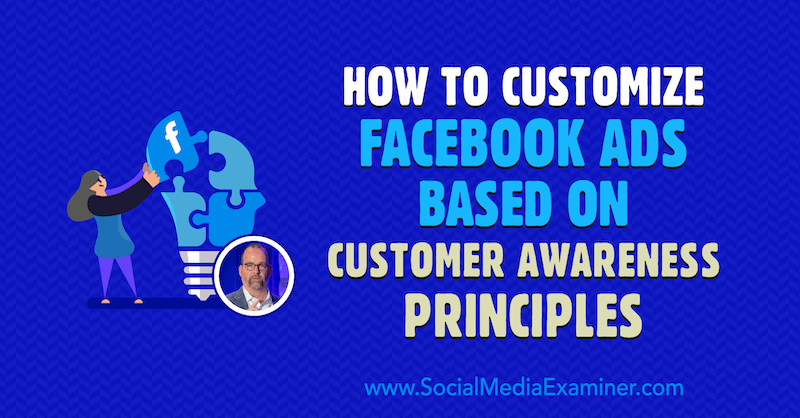
The Biggest Facebook Ad Mistakes Marketers Make
The biggest mistake marketers make when it comes to Facebook advertising is thinking it doesn't work because it doesn't perform like Google pay-per-click brand awareness ads or drive organic traffic from regular organic searches. Facebook ads are a completely different animal than Google ads and require a different approach.
With Google searches for a product, service, or company, there's a certain level of interest or intent to buy. Consumers expect there to be ads to inform their purchasing decisions. No one goes to Facebook looking for ads or to learn about a brand. Unless it's a well-known brand, expect that most Facebook users aren't even familiar with your company and what it offers.
Once you “crack the code on cold traffic” to your brand, your approach toward this audience can cultivate them into people who engage with your brand, service, or product. You can even turn them into lifelong customers. If you can drive cold traffic on Facebook, it can be the most tremendously effective ad platform there is for growing businesses.
Unlike Facebook, people actually do go on Instagram looking for brands and the network has become a shopping platform over the past 3 years. Of Instagram's 1 billion monthly users, 60%–70% discover new brands on the platform. Then 60% of those people actually make a purchase.
On average, U.S. users are spending 35 minutes a day on Facebook and 15 minutes a day on Instagram. Leveraging both Facebook and Instagram ads to drive cold traffic to your brand can be so powerful. Ralph notes that your ads should be Instagram-ready but realize that Instagram ads speak to the audience differently than Facebook ads.
Listen to the show to hear Ralph discuss how his company integrates Instagram ads into all of the media buying they do for brands they manage and why it's so effective for driving sales.
Breakthrough Advertising
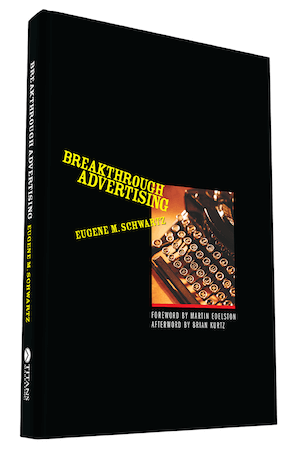 Ralph credits Breakthrough Advertising by Eugene Schwartz for informing his company's leveled customer awareness approach to Facebook ads.
Ralph credits Breakthrough Advertising by Eugene Schwartz for informing his company's leveled customer awareness approach to Facebook ads.
Get World-Class Marketing Training — All Year Long!
Are you facing doubt, uncertainty, or overwhelm? The Social Media Marketing Society can help.
Each month, you’ll receive training from trusted marketing experts, covering everything from AI to organic social marketing. When you join, you’ll also get immediate access to:
- A library of 100+ marketing trainings
- A community of like-minded marketers
- Monthly online community meetups
- Relevant news and trends updates
Eugene Schwartz was a very famous copywriter and he wrote this book after years of experience in advertising. He's credited with writing some of the most famous headlines and ads from the 1950s and 1960s. Although he originally wrote his book in 1966 and the forms of advertising have changed, its lessons are very much still relevant today. Human nature hasn't changed much and the principles of advertising remain the same.
The most famous segment of Breakthrough Advertising describes the Five Levels of Awareness as they relate to direct mail ads. Similar to email and digital marketing, advertisers at the time would cultivate mailing lists to which they would distribute hundreds of thousands of marketing materials.
The targeting of these direct mail lists was rather crude in comparison to social media targeting. They were comprised merely of basic demographic information or zip codes. Yet the same principles apply to both direct mail and Facebook ads.
Ralph describes Facebook along with other media as having content people want to see with ads wedged in. He talks about watching football on TV and seeing ads for Chevy. This advertiser assumes that people who enjoy watching football, presumably men Ralph's age, probably want to buy Chevy trucks. This is definitely not the case for Ralph so this specific advertising is poorly targeted.
Similarly, Facebook offers content from friends and family that its two billion-plus active users are interested in seeing with ads in between. The targeting on Facebook and Instagram is obviously a lot better than the targeting for TV ads.
The idea behind the customer awareness approach is to interrupt users with a message that resonates with them at that particular moment. For example, Ralph probably wouldn't see a Chevy ad in his Facebook news feed but he expects to see ads for guitars, sound systems, and other things that actually interest him.
Five Levels of Awareness
The Five Levels of Awareness as explained in Breakthrough Advertising describe a systematic way to speak to prospective customers based on how well they've identified their problems and needs.
Applying the Five Levels of Awareness to Ad Messaging
Everyone has problems and desires that they either know about or don't know about. Those that do know about their problems are likely looking for a way to solve them. Some of these people may be familiar with your products and services and are already buyers. Others may not be.
To measure where within the Five Levels of Awareness your target audience knows about your brand and your offerings, just ask one simple question: “What does my prospect already know?”
The answer to this question determines how you should target and tailor your ad messaging at each level. There are people at all five levels who are your potential customers but you have to talk to them a little differently at each level of commitment or depth of engagement on your website, Facebook ads, or page.
First Question: What Does the Prospect Already Know?
Ralph shares the story of Kleenex. Kleenex is now a well-known brand and a staple of our everyday lives. However, when the product launched decades ago, consumers had to be introduced to the idea of using a paper tissue instead of a handkerchief.
At the time, there didn't seem to be a need for Kleenex. People didn't think of handkerchiefs as spreading germs and being absolutely disgusting. The major challenge in advertising this new product to a completely unaware audience is that they didn't know they had a problem or that a disposable sanitary handkerchief was the solution. The company had to generate that need and desire through its advertising.
Unaware: Consumers Don't Know They Have a Problem
The Kleenex story has many modern equivalents. I offer that consumers didn't have a need or desire for an iPhone or any other device with a touchscreen until these products launched. It may not even be that your product is new to the market. Even with popular products and successful brands, there's always a portion of the market that's still unaware it exists, what it does, and how it can help them.
People at this first stage are unaware, and of all five levels, these people are the hardest and most challenging to reach with your advertising. Unaware audiences don't realize they have a problem to solve, even though they may be experiencing the frustrations of it. They might be doing the same things over and over again, never realizing or considering that a better way exists.
Perhaps they don't have time to think about it and aren't really looking for a solution yet. According to Eugene Schwartz, cracking the code on the unaware will be the great challenge of ad-men or -women. It will bring them great riches once they do.
What the unaware market needs is pure education. If Kleenex were to launch today, Ralph would recommend doing instructional videos showing how to blow your nose and emphasize its positive effects. He would show the after-effects of using Kleenex to stop the spread of germs, keep your house cleaner, and more.
Ralph's agency uses eight different video types at the first two levels of awareness, Unaware and Problem Aware audiences. They inform, demonstrate, and entertain but the focus should be on education and creating desire around your products. The goal of these videos is to pull cold audiences into your brand and get them to your website or sales page to learn more.
Problem Aware: Consumer Knows There's a Problem and Is Unsure of the Solution
At the second level, called Problem Aware, the audience is more informed that there's a problem but not that a solution exists. They certainly don't know about your company or your products. We explore the customer's mindset shifting from the first to the second level through sharing examples of two different products: solar panels and dried green juice.
Examples of Advertising at the Problem Aware Level
I share that I had no idea that the solar panels on my roof could generate more electricity until I received a direct mail postcard that said, “Did you know that you're losing X% of your electricity by not cleaning the solar panels on your roof?” I was unaware that dust on my solar panels was a problem until it was revealed to me by this form of marketing.
In a second example, Ralph describes introducing a new dried green juice powder with 11 superfoods to the market. His agency produced videos showing how the product gives you energy, helps you stay calm and focused, and suppresses your appetite between meals, among other great benefits.

After educating unaware audiences on how essential this product is for a healthier lifestyle, they now understand that some aspect of their health can be improved and a majority is probably ready to tackle the problem.

Discover Proven Marketing Strategies and Tips
Want to go even deeper with your marketing? Check out the Social Media Marketing Podcast! Publishing weekly since 2012, the Social Media Marketing Podcast helps you navigate the constantly changing marketing jungle, with expert interviews from marketing pros.
But don’t let the name fool you. This show is about a lot more than just social media marketing. With over 600 episodes and millions of downloads each year, this show has been a trusted source for marketers for well over a decade.
In both scenarios, as the customer, I'm not necessarily ready to hire the solar panel cleaning company on the mailer, nor are the video viewers convinced they should buy the dried green juice after first hearing about it. We're merely aware there's a problem at this level and will likely start gathering information or shopping around for the right solution. But we're not really ready to evaluate specific solutions just yet.
Approaching Problem Aware Audiences
The approach at the Problem Aware level must be somewhat indirect. Very similar to the Unaware level, marketers are still doing a fair amount of educating the audiences at this point. Ralph recommends targeting both the unaware and the problem aware audiences with the same type of top-of-the-funnel educational video content described previously.
When Ralph's agency started working with the dried green juice product over 4 years ago, they found hundreds of videos already produced and posted to the company's YouTube account. While all of the videos were really good, Ralph admits that none of them did the end-around with the main product where they educated and then pitched.
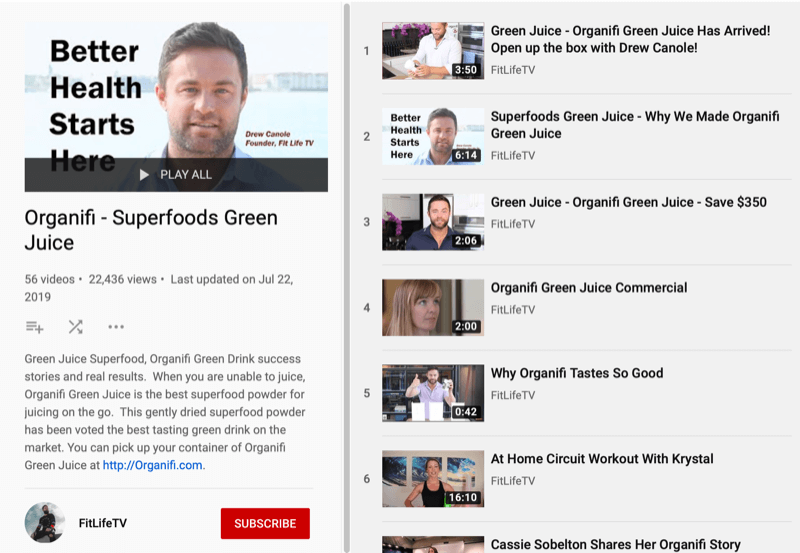
The agency ended up editing one of the company's longer YouTube videos by cutting it down and taking out some calls to action, among other things, and it's still running today in various incarnations.
The video's storyline introduces a brand spokesperson shopping for nutritious food and living a healthy lifestyle. He attributes his good health, energy, and great feeling to the 11 superfoods found in the dried green juice powder being promoted. He then explains some of the ingredients and lays out their potential benefits to the unaware and problem aware customer audience.
The point of the video is to educate audiences on the benefits of these superfoods that they may not be familiar with. Viewers can always go out and buy all of these individual ingredients or do more research elsewhere. Another of the brand's videos actually shows the enormous cost of individually sourcing each of the 11 superfoods found in the dried green juice and presents the product as the easy, all-in-one, less-expensive solution.
Solution Aware: Consumer Knows a Solution Exists
The third level is Solution Aware. These people recognize and understand there's a problem. They also realize there are options to solve it, but they haven't yet decided on the right one. They're shopping around for different potential solutions. These include people who have searched for your company online or opted into a lead gen offer.
As you move through the levels, your audience size narrows down and so should the focus of your ad messaging and targeting. When using Facebook ads, expect this level to be a much smaller target market.
While this portion of your audience might not generate many millions of dollars for your brand, your interest targeting can be highly focused on keywords that specifically relate to your brand or product. In the dried green juice powder example, Ralph's agency used a lot of variants for juicing, green juicing, and so forth.
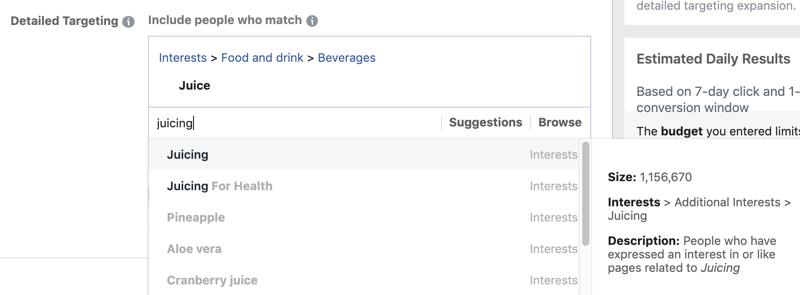
There are likely many other solutions in the form of products and services competing with yours. At this level, your messaging should be about differentiating your brand and your products and showcasing all that they do.
Using Facebook and Instagram ads, highlight the benefits that only you or your brand can offer and move audiences along to the next two levels, Product Aware and Most Aware, as quickly as possible. This is the only way to scale your business. Otherwise, potential customers will get stuck in the Solution Aware phase and limit your business's growth.
Listen to the show to hear Ralph discuss how to approach a solution aware audience when it comes to marketing conferences like Social Media Marketing World.
Product Aware: Consumer Knows Your Solution
Product aware prospects typically have a pretty good idea of what they need to solve their problem and they might know your brand exists. This audience is now considering specific solutions, which means your company has a chance to turn a qualified lead into a paying customer at this level.
In the example of the solar panel cleaning, the mailer not only identified that I have a problem and there could be a fix. It also offered a specific solution, which is to pay the company a quarterly retainer to clean the solar panels for me. Not only do I now know that their service provides the exact solution I need, but I also don't have to get up on the roof and break my neck.
With the video example for Ralph's dried green juice powder, the company took an unaware audience and transitioned them into being problem aware and then solution aware through their videos. Now this audience is ready to hear that the dried green juice is the exact product they need.
Once the viewer reaches the point in the video where the product is pitched as the solution, Ralph's agency begins referring to them as “product aware” and they're placed in a target audience with other people who get to this part of the video.
Their media buyers then build target audiences based on how much of the video a person has watched. They create an audience and present a very different marketing message to people who make it through 50%–75% of the video and hear the product pitch from those who only watched 25% or less of the video and haven't seen the pitch.
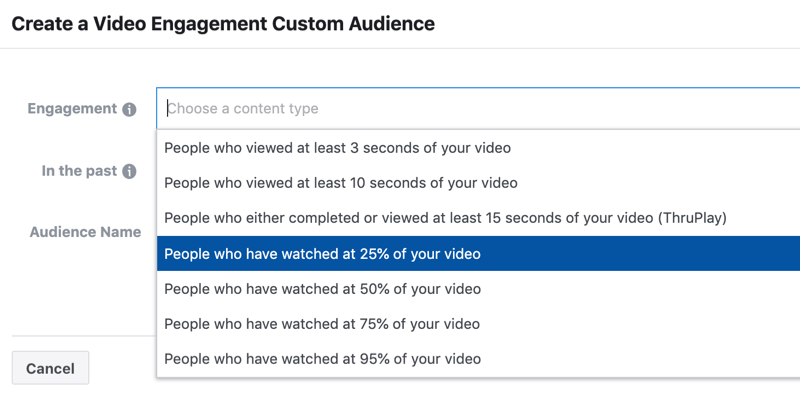
The 25% audience is targeted with more education, or in most cases, a different solution to their problem. They might get shorter videos, which get to the product reveal and to the Product Aware level faster. They might get served more problem aware videos that they watch longer, or view image ads or a variety of other resources that ultimately push them to be product aware.
Once the audience becomes product aware, you can start targeting them with ads for the specific products that meet their needs.
Most Aware: Consumer Is Considering Your Solutions or Is an Existing Customer
At the fifth level is your most aware customer. Most aware people know your brand, have experienced your products, and understand their value. The goal at this level is to maintain them as a customer by getting them to purchase again.
Subdivide and slice this level of customers into a lookalike audience along different parameters.
For example, separate an audience of the customers who have purchased more than two products from those who have purchased fewer items or whose average cart is less than $100. Ralph recommends enticing your most aware audience with a discount or loyalty code or upselling them on related products. Try different pitches for your different products and increase their average order value.
In the case of consumables like the dried green juice, schedule retargeting ads to be shown during the window of time that your most aware customer will most likely run out and need to reorder. If you expect your customers to use it every day, they'll likely need to restock within about 30–45 days or maybe 30–60 days of their initial purchase.
Most aware customers might make up your smallest audience but typically they guarantee the highest return on ad spend. It's easier to pitch and sell to most aware people because they already know who you are and realize that your solution is good. Someone who has bought from you eight times is much more valuable than someone who has just purchased once. Each of these two sub-audiences requires a different ad message.
Discovery of the Week
Tweet Photo allows users to tweet higher-quality Instagram photos than Instagram's native tools currently allow. The option to share an Instagram photo on Twitter as it's being posted to the platform generates a tweet with a link to the photo on Instagram, rather than actually showing the photo.
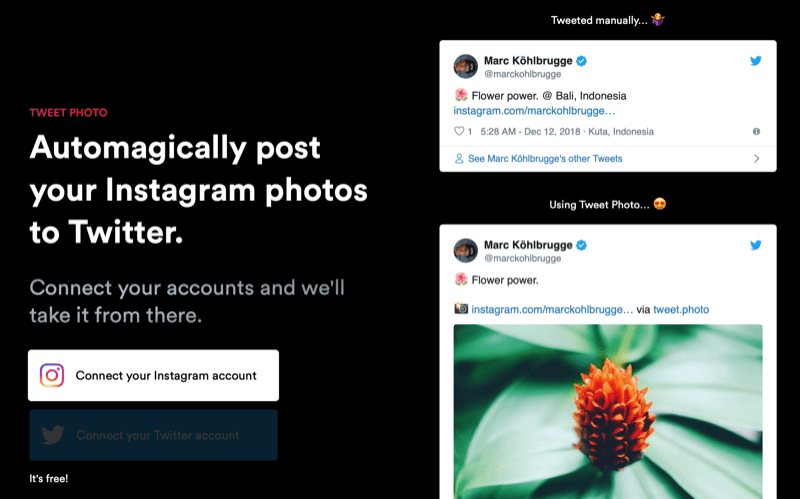
Tweet Photo connects your Twitter and Instagram accounts and enables you to tweet single Instagram photos as native photo tweets but not multiple-photo posts of videos on Instagram.
The caption on Instagram becomes the text for the tweet but only up to Twitter's limit of 280 characters. The tweet also includes a link back to the original Instagram post, thereby pushing traffic and encouraging engagement on your Instagram account while increasing your distribution.
Tweet Photo is available for free and can be accessed online.
Listen to the show to hear more about Tweet Photo.
Key Takeaways From This Episode:
- Check out Tier 11.
- Listen to the Perpetual Traffic podcast.
- Follow Ralph Burns on Facebook and LinkedIn.
- Read Breakthrough Advertising by Eugene Schwartz and Great Leads by Michael Masterson.
- Learn from the Tier 11 media buyers on a weekly basis with the Done With You program as part of the Ads Accelerator.
- Check out The Tier 11 Ads Accelerator Facebook group.
- Connect your Instagram and Twitter accounts with Tweet Photo.
- Check out Social Media Marketing World 2020.
- Watch exclusive content and original videos from Social Media Examiner on YouTube.
- Watch our weekly Social Media Marketing Talk Show on Fridays at 10 AM Pacific on Crowdcast.
Help Us Spread the Word! Please let your Twitter followers know about this podcast. Simply click here now to post a tweet.
If you enjoyed this episode of the Social Media Marketing podcast, please head over to iTunes, leave a rating, write a review, and subscribe. And if you listen on Stitcher, please click here to rate and review this show.
What do you think? What are your thoughts on using Facebook ads to target along the levels of customers' awareness? Please share your comments below.
Attention Agency Owners, Brand Marketers, and Consultants

Introducing the Marketing Agency Show–our newest podcast designed to explore the struggles of agency marketers.
Join show host and agency owner, Brooke Sellas, as she interviews agency marketers and digs deep into their biggest challenges. Explore topics like navigating rough economic times, leveraging AI, service diversification, client acquisition, and much more.
Just pull up your favorite podcast app, search for Marketing Agency Show and start listening. Or click the button below for more information.

